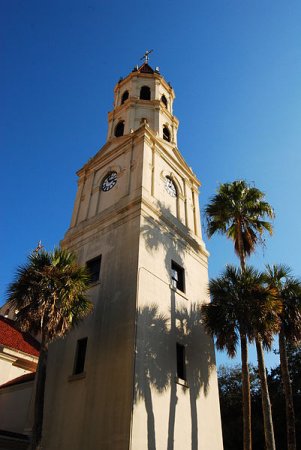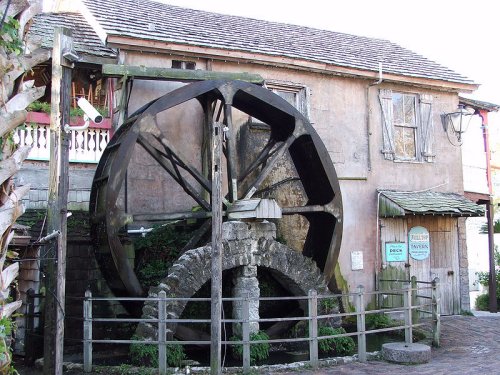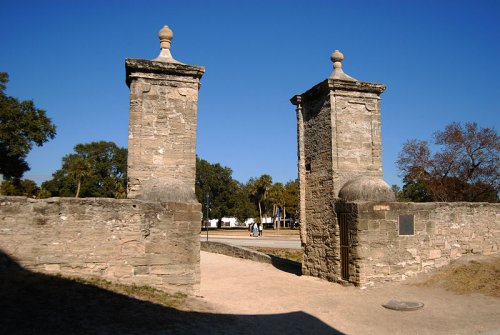
 Flagler College, formerly Ponce de León Hotel, in St Augustine
Flagler College, formerly Ponce de León Hotel, in St AugustineSource: https://commons.wikimedia.org/wiki/File:StAugFLSept07FlaglerD.jpg
Author: Infrogmation

St Augustine is a city in St Johns County, on the east coast of central Florida. Founded by the Spanish in 1565, St Augustine is the oldest continuously occupied European-established city in continental United States. Today it has a npopulation of about 12,000.
The area around St Augustine was first explored in 1513 by the Spanish explorer Ponce de Leon, who became the Governor of Puerto Rico. While the French explored the area in 1562, and established the settlement of Fort Caroline in 1564, it was the Spanish that established St Augustine in 1565.
 Tower of the Cathedral Basilica of St Augustine
Tower of the Cathedral Basilica of St AugustineSource: https://commons.wikimedia.org/wiki/File:Basilica_Tower.jpg
Author: Yakin669

That same year the French troops at Fort Caroline attempted to attack St Augustine. However their plans were thwarted by a storm, enabling the Spanish to counterattack, taking over Fort Caroline and renamed it San Mateo. Most of the French troops were executed, leading to the Spanish calling the inlet, Matanzas, meaning "slaughter."
In 1568 the French retaliated by attacking the Spanish at the former Fort Caroline, and massacred the Spanish troops in a similar fashion. Subsequent expeditions by the French were unable to eject the Spanish from the area.
Then in 1586, the British under Sir Francis Drake, pinning the blame for the disappearance of the Roanoke colony of English fishermen on the Spanish, attacked and burned St Augustine, driving the surviving settlers out of the area. However, he abandoned the area due to insufficient resources. In 1668 another English privateer Robert Searle attacked and plundered St Augustine, forcing the Spanish to beef up their defences. The 1763 Treaty of Paris gave St Augustine to the British in exchange of Havana to the Spanish. It returned to Spanish control in 1784, but was eventually ceded to the United States in the 1819 Adams-Onís Treaty.
 Old Mill in St Augustine
Old Mill in St AugustineSource: https://commons.wikimedia.org/wiki/File:Mill_in_St.Augustine.jpg
Author: Petr Berka

 Old City Gate, St Augustine
Old City Gate, St AugustineSource: https://commons.wikimedia.org/wiki/File:City_gate.jpg
Author: Yakin669

Fort Matanzas and Castillo de San Marcos are today National Monuments of the United States connected to the early history of San Augustine.
Visiting St Augustine, Florida
St Augustine can be reached on Interstate 95, turning off at Exit 318 and continuing east on Charles Usinas Memorial Highway (State Route 16).Places of Interest in St Augustine, Florida
- Alligator Farm Zoological Park
- Colonial Spanish Quarter Museum
- First Ripley's Believe It or Not! Museum
- Flagler Collge
- Florida's Oldest House
- Fort Mose Historic State Park
- Fountain of Youth
- Oldest Wooden Schoolhouse
- San Sebastian Winery
- St Augustine Lighthouse and Museum
National Monuments in St Augustine
 Latest updates on Penang Travel Tips
Latest updates on Penang Travel Tips
About this website

Dear visitor, thank you so much for reading this page. My name is Timothy Tye and my hobby is to find out about places, write about them and share the information with you on this website. I have been writing this site since 5 January 2003. Originally (from 2003 until 2009, the site was called AsiaExplorers. I changed the name to Penang Travel Tips in 2009, even though I describe more than just Penang but everywhere I go (I often need to tell people that "Penang Travel Tips" is not just information about Penang, but information written in Penang), especially places in Malaysia and Singapore, and in all the years since 2003, I have described over 20,000 places.
While I try my best to provide you information as accurate as I can get it to be, I do apologize for any errors and for outdated information which I am unaware. Nevertheless, I hope that what I have described here will be useful to you.
To get to know me better, do follow me on Facebook!
Copyright © 2003-2025 Timothy Tye. All Rights Reserved.

 Go Back
Go Back